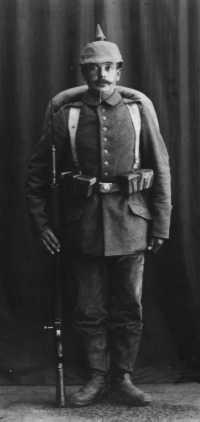Feldgrau(field grey) became the prominent uniform color in 1910 when Prussian Blue(Dunkelblau} was replaced.

This photo was taken in mid 1915.
The soldier's Pickelhaube (spiked helmet) is covered with the canvas cover.
Pre-war helmet covers would have had the regimental number indicated by a large red Arabic number.
In 1914, the color of the number was changed to dark green, and in 1915, it was left off altogether.
The leather used in the helmet was imported from Argentina. In 1914, the British blockade caused the first shortage of the war, leather for helmets. Felt and fibre board as well as tin or sheet metal was used as substitute materials for making helmets. Spiked helmets continued to be produced for enlisted men until the spring of 1916, when the Stahlhelm, (steel helmet), was introduced.
The soldier is wearing the 1915 Transitional tunic. A wartime measure simplified the tunic and eliminated the complex Brandenburg and Swedish cuffs of the 1910 uniform and replaced them with simple turn back cuffs. This style cuff was well liked by the soldiers, as all military passes and other I.D. required to be shown to military authorities could be conveniently stowed away in the fold of the wide turn back cuff.
Up to the end of the war the 1910, Transitional and 1915 Bluse type tunics continued to be produced. The soldier's belt buckle is the pre-war brass and silver type. Attached to his rifle is the shorter, butcher bayonet.
http://www.worldwar1.com/sfgeruni.htm